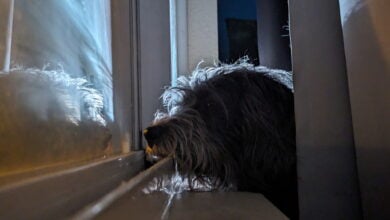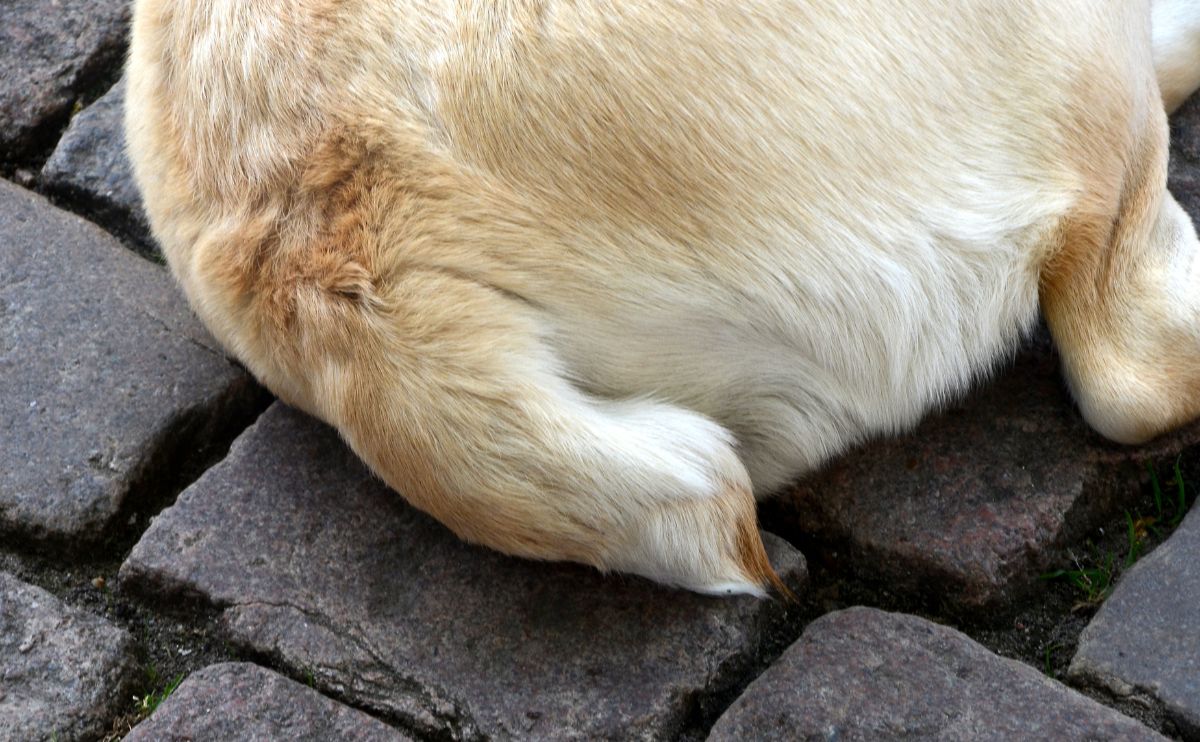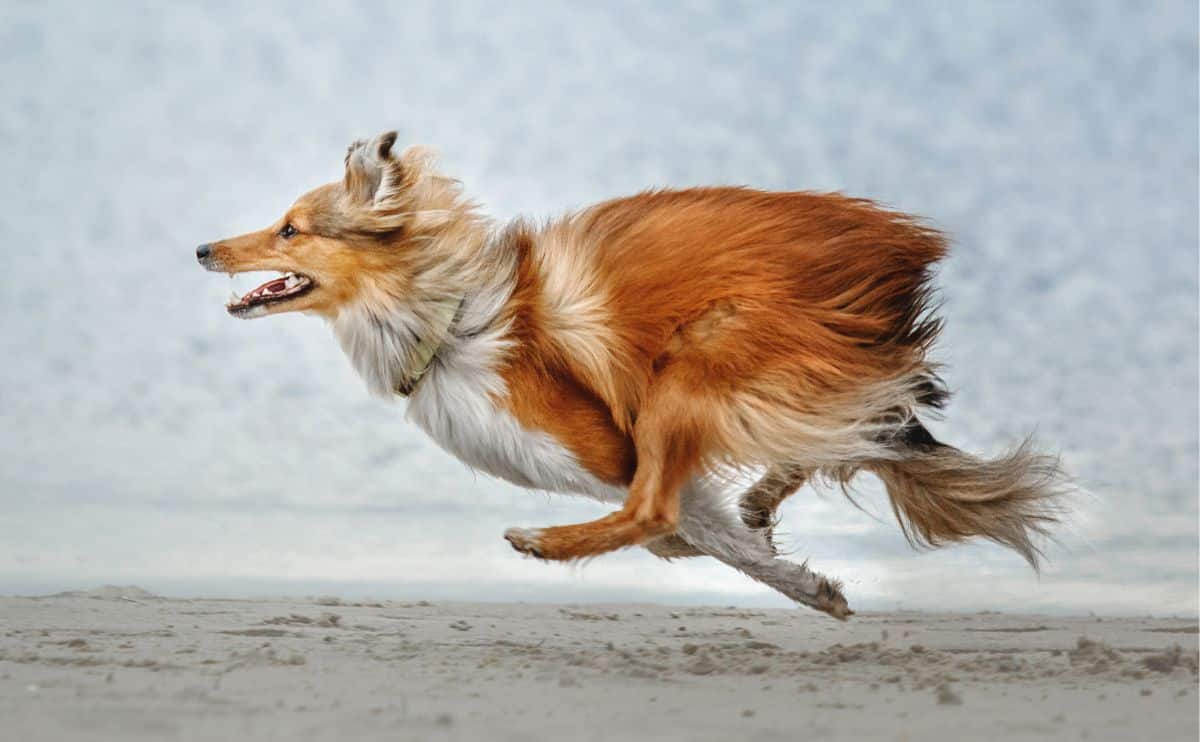When you purchase through links on our site, we may earn a commission. Here’s how it works.

You’ve seen it — that unmistakable pose where your Corgi drops flat on the floor, back legs stretched behind them like a frog in yoga class. Their belly hits the tile, tail stump wags, and they give you a look that says, “Yes, I’m fabulous — and flexible.”
Table of Contents
This, my friends, is the sploot, an internet-famous move that’s equal parts adorable and oddly athletic. While it’s become a meme-worthy trademark of the breed, splooting is more than just a Corgi quirk. It’s a behavior rooted in anatomy, comfort, and even canine communication.
But why do Corgis sploot more than most other breeds? And does it ever mean something’s wrong? Let’s stretch this topic out (literally) and dig into the science, structure, and charm of the Corgi sploot.
What Exactly Is A Corgi Sploot?
A Corgi sploot is when your dog lies flat on their belly with their hind legs stretched out behind them, sometimes extending their front legs too — a full-body sprawl that makes them look like they just melted into the floor.
Veterinarians call it a relaxed prone position, but dog people just call it cute. This pose isn’t unique to Pembroke and Cardigan Corgis, but their long backs, short legs, and flexible hips make them natural masters of the art.
In simple terms: A sploot = belly on the floor + legs out behind + one satisfied little loaf.

It’s become such a signature move that some Corgi owners joke their pups are “professional floor pancakes.” But as funny as it looks, this stretch-and-chill position actually serves several purposes for your dog’s body.
Did You Know? Corgis and several other breeds, such as Dachshunds and Basset Hounds, inherit a genetic mutation called chondrodysplasia (CDPA). This hereditary condition causes disproportionately short limbs while the body remains a normal size.
Where Did The Term “Splooting” Come From?
No one can pinpoint the exact moment the internet collectively decided on the word sploot, but it likely evolved from pet forums and social media in the 2000s. It’s believed to be a playful mix of splat and scoot, a term that perfectly captures the visual of a Corgi flopping onto the floor in one dramatic move.
Before the term sploot took over TikTok and Reddit, dog owners used other (less adorable) names like:
- Flying squirrel
- Frogging, frog dog, or frog legs
- The superman
- Pancaking
- Furry turkey, drumsticks, or turkey legs
Today, “splooting” has gone viral beyond Corgis. You’ll find it in memes, hashtags, and even academic discussions about animal behavior and flexibility — proof that science and the internet occasionally agree on what’s cute.
Why Do Corgis Sploot? 6 Reasons Corgis Get Down Low
Corgis are walking contradictions: half herding dog, half couch potato, and somehow 100% drama. Their famous sploot fits right in — it’s part comfort stretch, part performance art.
Here’s what’s really going on when your pup suddenly drops into a full belly sprawl.
1. Because It’s Comfortable (And They Know It)
For most Corgis, the sploot is simply the comfiest position in the world. It lets them rest their core while keeping an eye (and ear) on everything happening around them — a perfect balance of relaxation and readiness.
You might see your Corgi flop down mid-play or after a walk, legs stretched behind like they’re sunbathing. It’s not a sign of laziness; it’s just their version of a full-body exhale.
2. To Cool Down Their Bellies
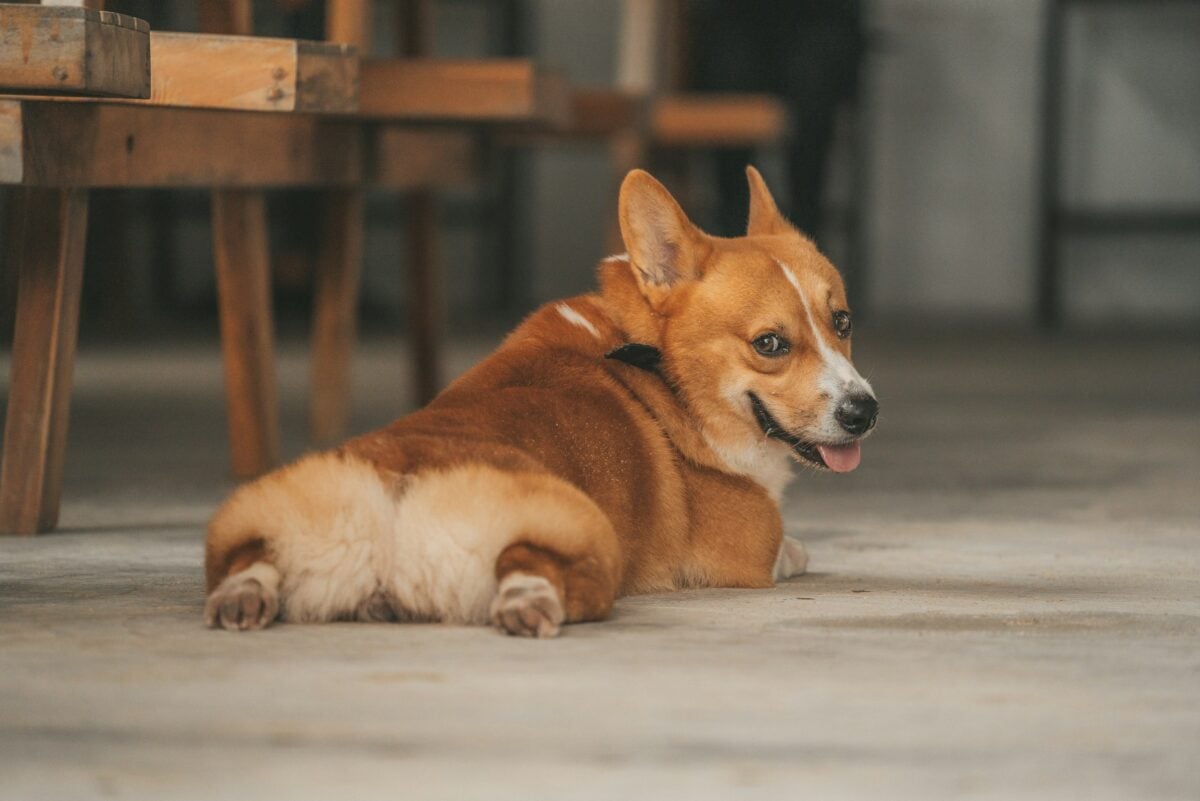
Those short legs and thick double coats make Corgis prone to overheating. When they sploot on tile or hardwood, they’re doing a built-in temperature reset.
By pressing their belly, one of the least furry parts of their body, against a cool surface, they can lower their body temperature naturally after zoomies or outdoor play.
Vet insight: Dogs are more prone to heat stroke than humans. Veterinary experts advise pet parents to cool their pup’s belly during heat stress.
3. For That Good Stretch
Think of a sploot as your dog’s version of a yoga pose. After running, herding, or a long nap, Corgis stretch out to relieve muscle tension and keep their joints limber. You might even notice a few little grunts or sighs — the canine equivalent of, “Ah, that’s better.”
This stretch helps them maintain hip and spine mobility, especially important for breeds with elongated bodies like the Pembroke and Cardigan Welsh Corgi.
If splooting were yoga, your Corgi would be the full-time instructor.

4. Because They Know You’ll Notice
Corgis are smart, social, and shameless attention magnets. If you laughed, took a photo, or gushed, “Look at those legs!” the last time your dog splooted, congratulations; you’ve just reinforced the behavior.
Over time, some Corgis sploot deliberately when they want praise or affection. It’s basically their way of saying, “You liked this last time, right? Let’s do it again.”
5. It Feels Great on Flexible Joints
Younger Corgis are often serial splooters because their hips and joints are more flexible. Puppies and adolescents can comfortably extend their hind legs, while older dogs may prefer tucking one or both in (you’ll see this later in the “Variations” section).
Splooting can even help strengthen hip flexors and leg muscles by engaging them gently, like a low-impact stretch for humans.
6. It’s a Built-In Core Workout
Here’s the secret bonus of all that floor lounging: splooting subtly engages the hips, glutes, and abdominal muscles. It’s part stretch, part strengthening exercise, helping maintain healthy mobility, especially when paired with daily walks and playtime.
So yes, your Corgi may look ridiculous, but that “pancake pose” might be doing their little body some real favors.
Is Splooting Normal?
Absolutely. Most sploots are harmless and healthy. The only time to worry is if your Corgi suddenly starts splooting more often than usual or seems stiff getting back up — that could point to joint pain or discomfort.
Variations Of Corgi Splooting
Because one sploot pose simply isn’t enough.
Corgis don’t just sploot — they customize it. Depending on their mood, flexibility, or favorite nap spot, your pup might serve up one of several distinct versions. Each variation tells its own little story.
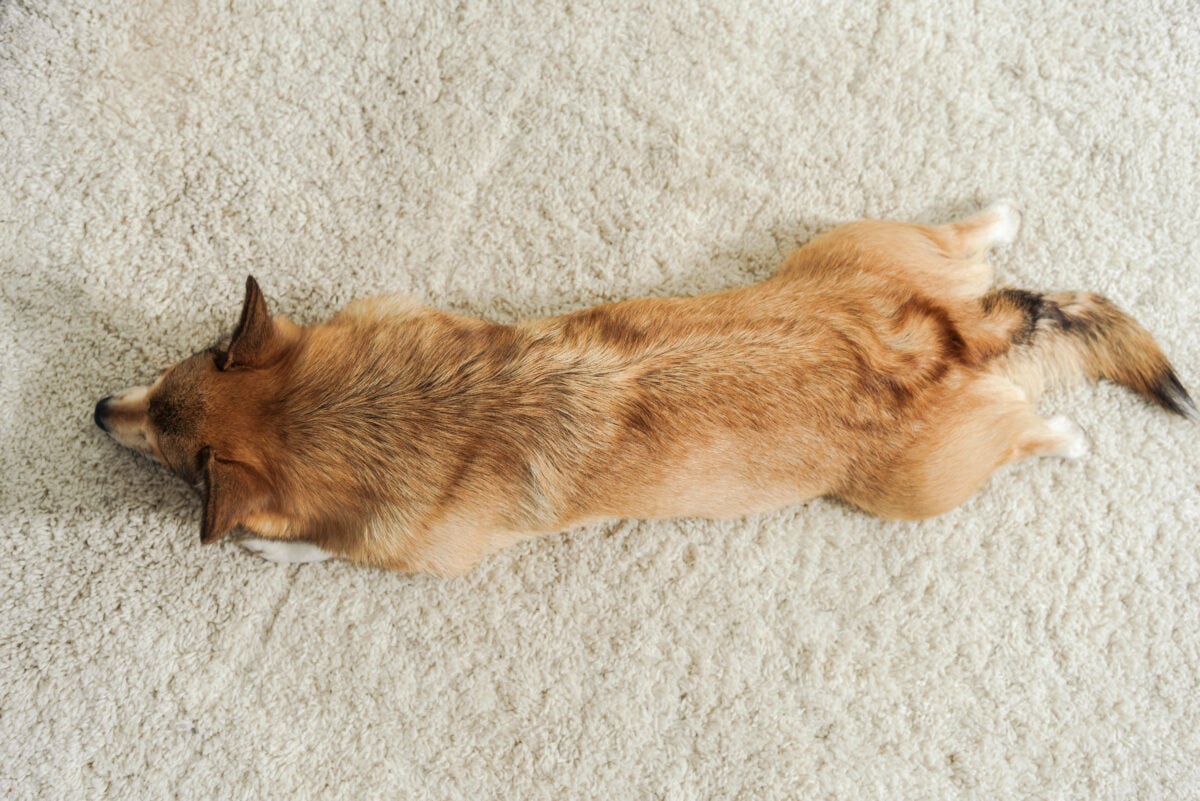
Here’s your official Corgi Sploot Style Guide:
- The Half Sploot
One leg stretched behind, the other tucked in. It’s a “half-committed” lounge, perfect for dogs who can’t decide between napping and sprinting. - The Pancake Sploot
The classic. All four legs extended flat, belly pressed to the ground, and face planted in pure contentment. It’s the version most Corgi parents know and adore — the floor pancake that launched a thousand memes. - The One-Sided Sploot
One leg out, one under, kind of like a Corgi casually reclining at the pool. It’s usually seen after mild exercise or playtime, when your pup’s deciding whether they’re done moving for the day. - The Right or Left Side Sploot
A more advanced stretch, with both hind legs extended to one side of the body. You’ll often see this during grooming breaks or lazy sunny mornings — a show of flexibility and confidence. - The Back Sploot (aka Upside-Down Edition)
When a Corgi truly lets go of all dignity, you’ll find them on their back, belly up, paws in the air like a tiny furry starfish. It’s not technically a sploot, but it earns an honorary mention for sheer comedic value.
Each sploot variation has one thing in common: relaxed hips, happy joints, and total comfort. The style may change, but the message is always the same — life is good.
Why Splooting Is So Associated With Corgis
Short legs. Long backs. Maximum drama.
While other breeds sploot, Corgis practically invented it. Their anatomy makes them especially good at it, and their personalities make them especially likely to show it off.

Here’s why splooting feels like a Corgi trademark:
- They’re built for it.
Corgis have short femurs and a long spine, giving them natural flexibility through the hips and back. That makes lying flat far easier and way more photogenic than it is for most dogs. - They’re attention experts.
Corgis are herders by nature, which means they’ve evolved to read human body language and seek interaction. When they sploot and you laugh, they clock it immediately and repeat the move. (Congratulations — your dog is training you.) - They’re expressive to their core.
Between the wiggly butts, big ears, and smug smiles, Corgis are masters of comedic timing. The sploot adds another tool to their expressive arsenal — a dramatic pose that says, “Observe me, peasants.”
What Other Dog Breeds Sploot?
It turns out, Corgis aren’t the only ones who drop it low.
While Corgis may be the poster children of the sploot, plenty of other breeds enjoy this full-body flop, especially those with compact builds or flexible hips. You’ll see similar stretches from several short-statured, long-bodied dogs and a few surprising copycats.
Here are a few of the most frequent splooters outside the Corgi family:
- French Bulldogs: With their stocky frames and natural hip flexibility, Frenchies are notorious for dramatic sploots on cool tile floors. Bonus points for the snort that often follows.
- English Bulldogs: Built low to the ground with wide hips and a love of lounging, English Bulldogs are natural splooters. You’ll often find them belly-down after a walk, cooling off while pretending they’ve just finished a marathon.
- Dachshunds: Another long-backed breed that loves a good floor sprawl. For Doxies, it’s both a stretch and a sign they feel safe enough to fully relax.
- Pugs: Compact and confident, Pugs often sploot after playtime — it’s their post-zoomie cooldown move.
- Boston Terriers: Short legs and a playful streak make them sploot champs, often mid-nap between bursts of energy.
- Labrador Retrievers (especially puppies): Big dogs can sploot too! Young Labs and Goldens often go full “Superman mode” before they grow out of that youthful flexibility.

While these breeds make splooting look effortless, Corgis dominate the trend because of their combination of unique body shape, quirky personality, and internet fame. If splooting were an Olympic sport, the Corgi would absolutely take gold — and pose for a photo afterward.
Is Splooting Harmful To Dogs?
Most of the time, splooting is perfectly normal and healthy. It’s a sign your dog feels safe, flexible, and comfortable enough to sprawl out completely.
But in some cases, frequent or sudden splooting can signal discomfort, especially if your dog seems stiff afterward or avoids getting up.

When It’s Normal vs. When To Worry
| Normal Splooting | Potential Problem |
|---|---|
| Flops down after playtime | Sudden increase or stiffness |
| Gets up easily afterward | Whines or hesitates standing |
| Alternates sides freely | Always favors one side |
Here’s how to tell the difference between a happy stretch and a possible health issue.
Trauma Or Muscle Strain
If your dog recently slipped, fell, or landed awkwardly, they might sploot more often to ease tightness or stretch sore muscles. Watch for limping, reluctance to jump, or whimpers when they move. These may point to soft tissue strain that needs veterinary care.
Arthritis
Older Corgis sometimes use splooting as a temporary relief position for joint stiffness. However, arthritis usually makes the full extension harder over time, not easier. If your senior pup is having trouble getting up, avoiding stairs, or showing stiff morning movement, schedule a vet exam to discuss pain management and supplements.
Hip Dysplasia
Because of their structure, Corgis can be predisposed to hip dysplasia, a condition where the hip joint doesn’t fit properly in its socket. While splooting itself doesn’t cause dysplasia, dogs with mild cases might sploot to relieve pressure or stretch tight muscles.
If your Corgi starts splooting more than usual, seems sore afterward, or struggles to keep their back legs aligned, it’s time for a vet appointment and possible X-rays.
See our guide on the 10 most common health issues in Pembrokes & Cardigans and the best pet insurance for Corgis to know what your pup may encounter in the future and how insuring your pup can benefit your finances and your pup’s well-being.
The Weight Factor: Obesity In Corgis
A few extra pounds can turn a healthy sploot into a struggle. Corgis are prone to weight gain, and carrying excess weight strains their joints, making splooting more difficult or even painful.
Keeping your pup lean with a balanced diet and regular exercise helps preserve the mobility that makes splooting (and zoomies) effortless.
When To Call The Vet
Splooting + any of these signs = time for a checkup:
- Trouble standing up or climbing stairs
- Limping, stiffness, or yelping after play
- Uneven leg movement during sploot
- Sudden increase in splooting in an older dog
Most of the time, though, a sploot just means your Corgi is stretching their legs and loving life. As long as they get up easily and move normally afterward, you can relax. It’s all part of the Corgi charm.
Do Other Animals Sploot?
If you thought only Corgis mastered this pose, think again. Splooting has taken over the animal kingdom, from cats and squirrels to bears and otters, and social media has the receipts.
You’ll find everything from #CatSploot hashtags to zoo TikToks of lounging red pandas. Here’s who else is embracing their inner floor pancake:
- Cats – Especially younger or more flexible ones. Cat sploots tend to happen during warm naps, sunbathing sessions, or moments of pure “I own this place” confidence.
- Squirrels – They’ve been caught splooting on sidewalks and tree branches to cool off — same logic, smaller legs.
- Otters & Ferrets – Long, limber bodies make these critters natural splooters, often mid-play or post-meal.
- Bears – Wildlife cams have captured bears splayed out flat in the summer heat, proving splooting might be nature’s universal cooling system.
In other words, splooting isn’t just a Corgi thing; it’s an attitude. Relaxed, confident, and unbothered. The pose of kings, queens, and four-legged goofballs everywhere.
Frequently Asked Questions
Before we wrap up, let’s tackle a few of the most common questions Corgi parents ask about this iconic pose. If your question isn’t listed here, drop it in the comments! Our Canine Journal team (and fellow sploot-loving readers) love sharing real-life Corgi stories and tips.

Do All Corgis Sploot?
Most do, but not all. Every Corgi has their own comfort preferences and joint flexibility. If your dog doesn’t sploot, don’t worry; it’s not a sign of anything wrong. Some just prefer curling up like a loaf or stretching on their sides instead.
Do Corgis With Hip Dysplasia Sploot More Often?
Sometimes, yes. Dogs with mild hip issues may sploot to relieve tension or stretch their muscles. But it’s a fine line. If splooting becomes frequent or awkward, it’s worth having your vet check for joint problems.
Can Splooting Cause Joint Problems?
No. Splooting doesn’t cause joint issues in a healthy Corgi. It’s typically a symptom, not a source, of discomfort. Think of it as a reflection of flexibility rather than a risk factor.
Should I Let My Corgi Sploot On Hard Floors?
Absolutely. Just make sure the surface isn’t too slick or hot. Tile, hardwood, or concrete are all fair game, and often your Corgi’s top picks for cool-belly comfort zones.
Keeping Your Corgi Happy & Healthy
At the end of the day, the Corgi sploot is equal parts stretch, statement, and personality. It’s how these short-legged comedians cool down, stay flexible, and (let’s be honest) entertain the humans who adore them.
To keep your Corgi feeling their best, explore our guides on the best dog food for Corgis, the best joint supplements for dogs, and the best dog beds for Corgis. Small habits, from diet to exercise, can go a long way in keeping that sploot smooth for years to come.
Does your Corgi have a favorite splooting style or quirky floor spot? Share your story in the comments below!


